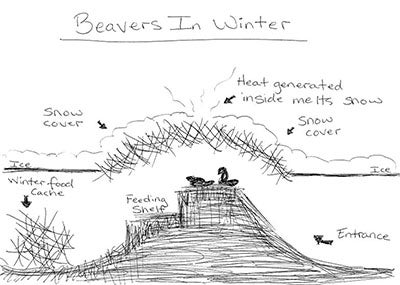Nature Notes: Beavers in winter
Published 5:31 pm Tuesday, November 30, 2021
|
Getting your Trinity Audio player ready...
|
By Sydney Weisinger
Teacher/Naturalist
One of my favorite classes to teach as an environmental educator is about beavers. Why beavers, you may ask, sounded stunned because beavers are just a nuisance. That is exactly why I like teaching about them, because most people do not think highly of them or do not think of them at all! I am here to tell you that they are very interesting, intelligent, and beneficial creatures.
I would start this class off with a drawing on the board, like the one pictured here, but without all the explanation arrows. I would ask the students what they thought was going on here and then to draw their thoughts on the board. Now their drawings would not be as scientifically correct as mine, but they were very entertaining and fantastical. The one thing we all agreed on is that there is a lot of activity that goes on under the water that we cannot see!
Beavers are part of the mammal class and the largest member of the rodent family. They can grow to be four to six feet long and weigh 40 to 60 pounds. Beavers mate for life and usually mate in February. They have anywhere from three to nine babies, called kits, which are born in May. Young beavers usually live with their parents for two winters, so there could be anywhere from six to 18 kits in a lodge over winter.
When the two year old kits are kicked out of their parent’s lodge at the end of winter, they have to find a suitable territory to call their own. Beavers will build lodges if a suitable river bank is not available to burrow into. They try to build these lodges as far from the shore as possible to keep predators away. It is important that they have a constant water depth of about five feet, or else it takes too many resources to build a suitable lodge. They will spend the summer chopping down trees and dragging most of them under the water and stick them in the mud to be stored as a winter cache. They are also finding old fallen trees or braches to make their lodge out of and packing as much mud as they can into the cracks and crevices to get it to hold. This winter cache includes the bark from aspen, birch, willow, alder, and some shrubs.
As winter approaches they start growing in an even thicker, coarser coat or pelt, which they comb through with an oil they secrete which helps them repel water. Beavers will cut and cache food until the water around their lodge has frozen over. By this they should have a nice dry area above the water level in their lodge where they can eat and sleep. They only go into the water to collect food from their cache. Throughout winter the inside of the lodge stays right around 40 degrees Fahrenheit regardless of the harsh conditions outside. This is in part because of the fluffy snow that has accumulated on top of the lodge, creating more insulation. If you are lucky enough to find a beaver lodge in the winter, you may be able to see steam coming off the top of the lodge due to the warmth inside!
What’s Happening at the Nature Center in December
• Winter and Spring Classes and Activity Registration is Open Online
• Dec. 8: Free Live Bird Program, 4-4:30 p.m.
• Dec. 20: American Red Cross Blood Drive, noon to 6 p.m.
• Dec. 24-25: Interpretive Center Closed
• Dec. 31: Deer Hunt Ends and Interpretive Center Closed



